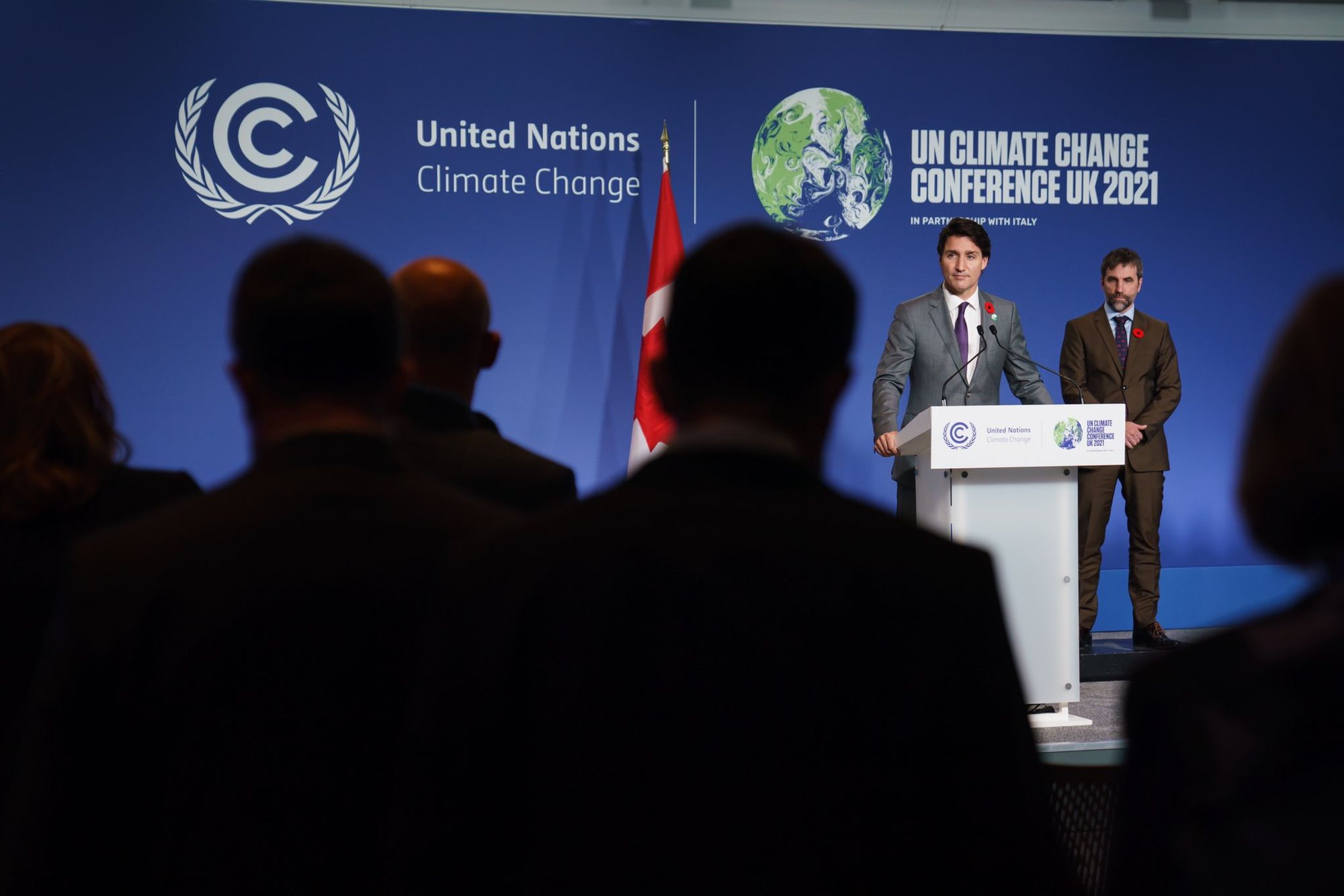This year’s United Nations Climate Change Conference, held in Glasgow, will come to a close today.
Canada came to the conference with a poor record on climate change, currently having the third-highest carbon dioxide emissions per person of the G20 countries, behind only Australia and Saudi Arabia. There are 14.4 tonnes of greenhouse gasses (GHG) emitted for each person in Canada, more than the 13.7 tonnes per American and 8.2 tonnes per person in China. Canada is also the 10th worst carbon emitter in the world, of all time.
At the conference, the government made a whole series of new promises to cut emissions going forward, including: a cap on oil and gas emissions, reducing them by 40 to 45 per cent compared to 2005 levels by 2030; net-zero emissions from the electricity grid by 2035; a reduction in methane levels to be 30 per cent less than 2020 levels by 2030.
Yet while these goals may sound commendable, history has shown that Canada has failed to meet every single major climate goal. Here is a timeline of these climate change commitments, and just how widely Canada missed the mark in achieving them.
Government of Canada Action Plan
- Year: 2000
- Goal: Reduce GHG emissions by 65 million tonnes per year from 2008 to 2012.
- Met: No.
- Annual emissions in million tonnes:
- 2008 = 736
- 2009 = 694
- 2010 = 703
- 2011 = 714
- 2012 = 717
- Details: Canada reduced GHG emissions from just one of the four years to another, due in large part to the recession, and by just 42 million tonnes. Emissions increased for the rest of the period in question, bringing them to just 19 million tonnes lower in 2012 than in 2008.
Climate Change — Achieving Our Commitments Together
- Year: 2002
- Goal: Reduce GHG emissions by 240 million tonnes from the projected 2010 level.
- Met: No.
- Annual emissions in million tonnes:
- Projected 2010 level = 801
- Target = 561
- 2002 = 727
- 2003 = 745
- 2004 = 746
- 2005 = 739
- 2006 = 730
- 2007 = 752
- 2008 = 736
- 2009 = 694
- 2010 = 703
- Details: The projected 2010 level if no action were to be taken was about 801 million tonnes, making the goal, at most, 561 million tonnes by 2010. Canada failed in each year, with all but two of them actually having higher emissions than in 2002.
Kyoto Protocol
- Year: 2005
- Goal: Reduce GHG emissions to an average of 6 per cent below the 1990 emission level, over the 2008 to 2012 period.
- Annual emissions in million tonnes:
- 1990 level = 602
- Target = 566
- 2008 = 736
- 2009 = 694
- 2010 = 703
- 2011 = 714
- 2012 = 717
- Met: No.
- Details: The 1990 emission level was 602 million tonnes, and the goal was 566 million tonnes. Canada didn’t get anywhere near its goal in any of the five years between 2008 and 2012. In fact, emission levels were higher than in 1990 for each of the five years. As opposed to a 6 per cent reduction, emission levels rose by as much as 22.3 per cent. The average emission level for the five years was 712 million tonnes, an 18 per cent increase from the 1990 level.
Canada withdrew from the Protocol in 2011 under Prime Minister Stephen Harper, who in 2002 wrote, “Kyoto is essentially a socialist scheme to suck money out of wealth-producing nations [that is based on] tentative and contradictory scientific evidence.”
Project Green
- Year: 2005
- Goal: Reduce GHG emissions by 270 million tonnes per year from 2008 to 2012.
- Annual emissions in million tonnes:
- 2008 = 736
- 2009 = 694
- 2010 = 703
- 2011 = 714
- 2012 = 717
- Met: No.
- Details: Canada reduced its GHG emissions by just 19 million tonnes from 2008 to 2012.
Turning the Corner (And Additions)
- Year: 2007
- Goal: Reduce GHG emissions by 20 per cent below the 2006 level by 2020. Reduce total GHG emissions by 60 to 70 per cent by 2050.
- Annual emissions in million tonnes:
- 2006 level = 730
- Target = 584
- 2007 = 752
- 2008 = 736
- 2009 = 694
- 2010 = 703
- 2011 = 714
- 2012 = 717
- 2013 = 725
- 2014 = 723
- 2015 = 723
- 2016 = 707
- 2017 = 716
- 2018 = 728
- 2019 = 730
- Met: Not yet.
- Details: The 2006 emission level was 730 million tonnes. The goal is 584 million tonnes by 2020, and between 219 and 292 million tonnes by 2050. Emissions were lower than in 2006 in 10 of the years in this period, but just by a range of 2 to 42 million tonnes. As of 2019, Canada’s emission level was the same as in 2006. Ultimately, Canada has thus far missed its goal by 146 million tonnes, and no progress has been made toward the 2050 goal.
Copenhagen Accord
- Year: 2010
- Goal: Reduce GHG emissions by 17 per cent below the 2005 level by 2020.
- Annual emissions in million tonnes:
- 2005 level = 739
- Target = 613
- 2006 = 730
- 2007 = 752
- 2008 = 736
- 2009 = 694
- 2010 = 703
- 2011 = 714
- 2012 = 717
- 2013 = 725
- 2014 = 723
- 2015 = 723
- 2016 = 707
- 2017 = 716
- 2018 = 728
- 2019 = 730
- Met: Not yet.
- Details: The 2005 emissions level was 739 million tonnes, and the goal is 613 million tonnes. Canada did not reduce emissions by its target in any of the years in this period, although it did emit less than in 2005 in all but one of the years. The closest it came to achieving this goal was in 2009, but it only made it 36 per cent (45 million tonnes) of the way there.
Paris Accords
- Year: 2015
- Goal: Reduce GHG emissions by at least 30 per cent below the 2005 level by 2030, and achieve net-zero emissions by 2050.
- Annual emissions in million tonnes:
- 2005 level = 739
- Target = 518
- 2006 = 730
- 2007 = 752
- 2008 = 736
- 2009 = 694
- 2010 = 703
- 2011 = 714
- 2012 = 717
- 2013 = 725
- 2014 = 723
- 2015 = 723
- 2016 = 707
- 2017 = 716
- 2018 = 728
- 2019 = 730
- Met: Not yet.
- Details: The 2005 emissions level was 739 million tonnes, and the goal is 518 million tonnes. Canada has not gotten close to achieving this goal, with its best year amounting to a 9.4 per cent reduction..
Environment Canada’s projections, as analyzed in a recent climate report, have Canada meeting upcoming targets under the Paris Accords, and being able to reduce emissions 30 per cent compared to 2005. But, according to the report’s research, those projections are misguided.
That report, by the Trottier Energy Institute, examines the government’s projections, as well as a number of outside carbon emission projections. It finds that the projections done by Environment Canada are “significantly more optimistic” than those of outside projections, one of which stated that current measures will lead to an, at most, 16 per cent reduction. In order for the Environment Canada projections to come to fruition, the report argues “a swift change in historical trends and aggressive and efficient action” would be required.
As the Trottier authors lay things out in their introduction, “Four sectors are deemed critical: power generation, oil and gas production, transportation, and buildings. However, planning for the thorough transformations expected in these sectors does not seem to have started.”
This is the key issue. It’s not just up to the federal government. The provinces need to do more than pay lip service to wanting to fight climate change, and put plans into place.
It’s not all bad news, though, as there’s a chance emissions could see significant reductions.
“It is both technologically and economically possible to reduce Canada’s GHG emissions by 40 per cent within the next 10 years. However, major rapid actions, beyond what is already publicly announced and in place, are needed to succeed,” the Trottier report says. “These actions must be coordinated between various orders of government. These actions must start now.”
Five years have passed since the Paris Accords came into force. Time has been running out for too long, and still not nearly enough has been done. This needs to change if there’s any hope of Canada breaking its historical trends, and meeting future climate goals.







Member discussion